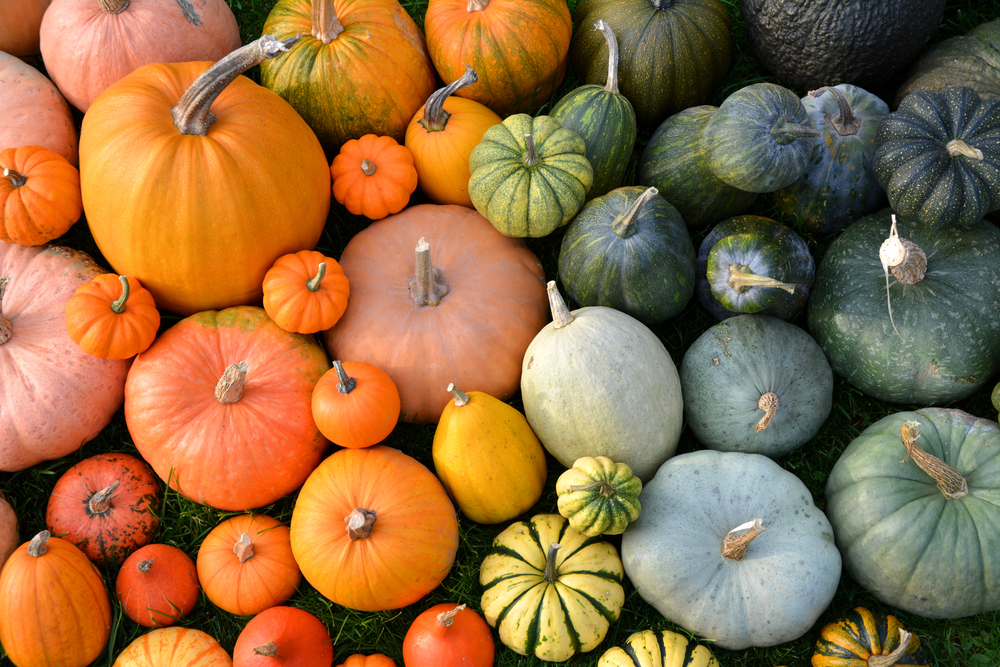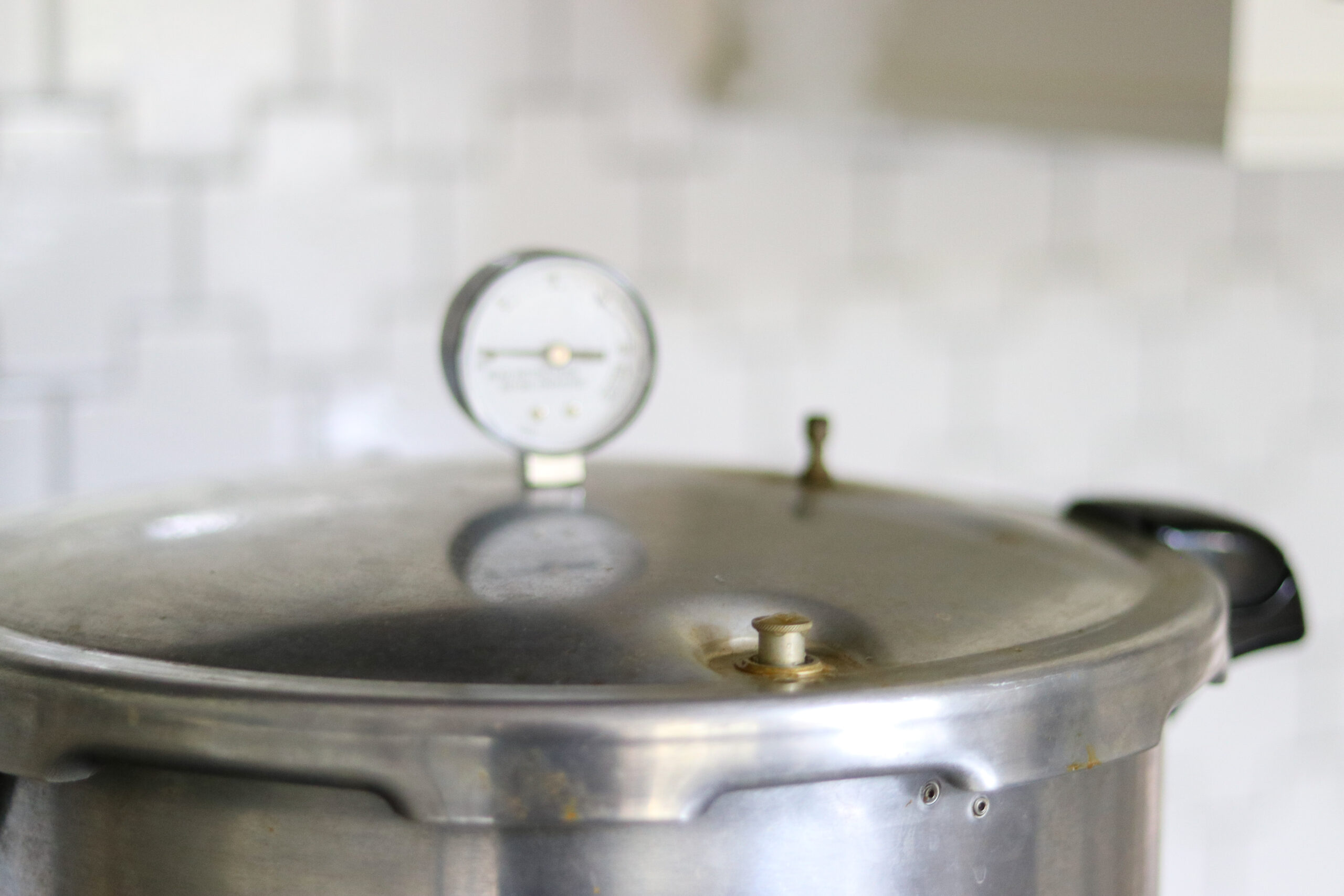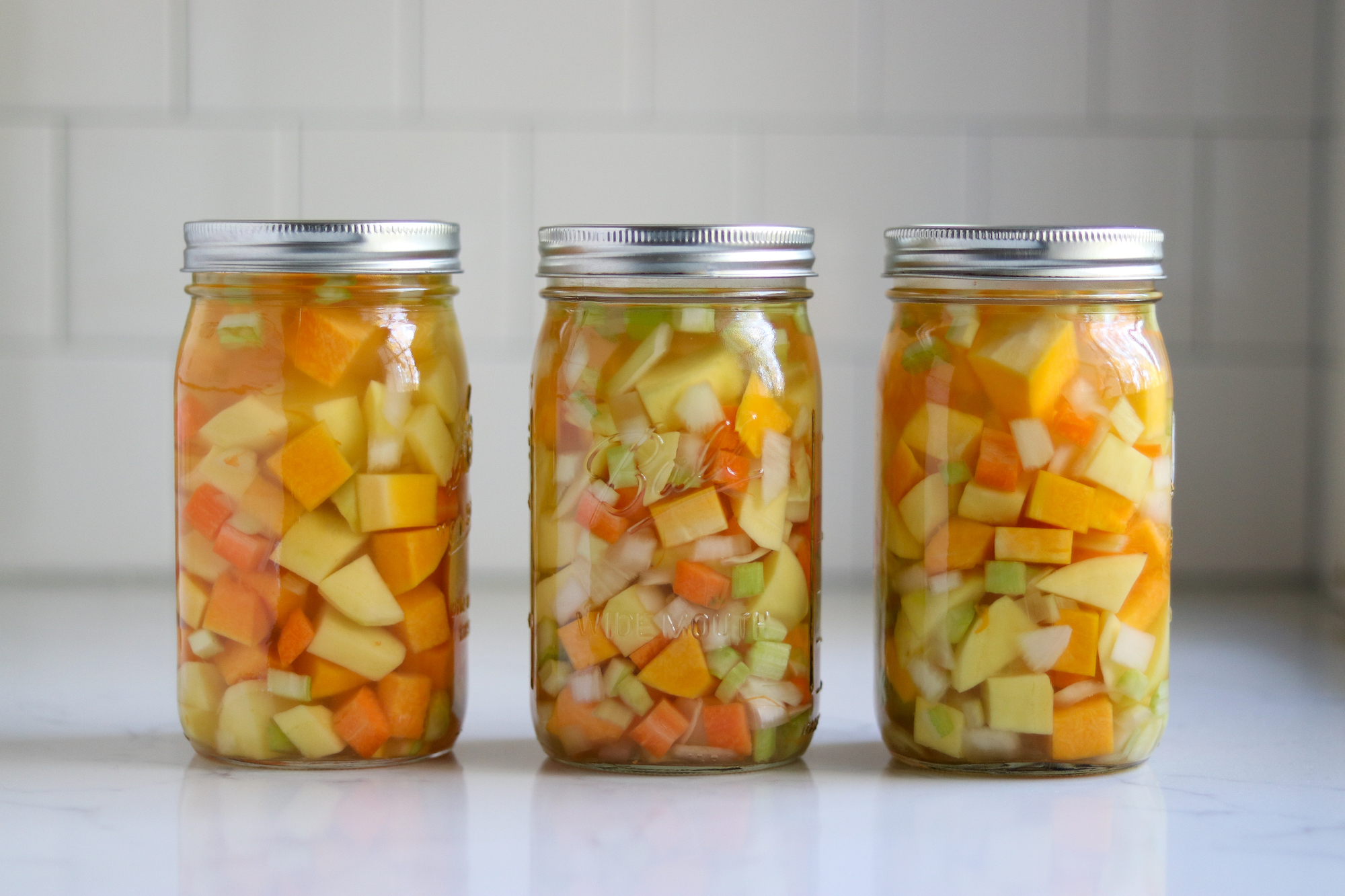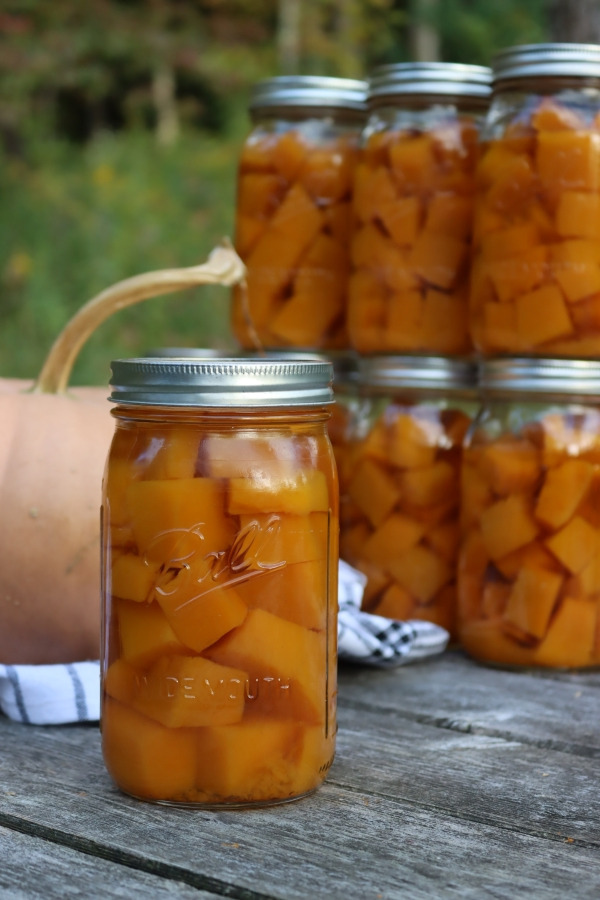This post may contain affiliate links. Please see our disclosure policy.
Canning pumpkin (and other winter squash like butternut, kabocha, etc.) can be tricky, at least for home canners, but there are a number of safe and tested recipes to get the job done.

Winter squash do well in a root cellar but few people have that kind of cold storage anymore. Even if you’re lucky enough to have a convenient basement root cellar, cleaning and roasting pumpkin is time consuming on busy weeknights. It’s a lot easier to batch the work all at once, canning pumpkin for many meals later down the road.
A can of pumpkin on the pantry shelf can be a lifesaver for busy holiday meals, and it’s alot easier to pull ready cleaned and cooked pumpkin down from the pantry than it is to roast a whole pumpkin as needed.
There are plenty of recipes for canning pumpkin at home, be it as plain cubes in water, broth or syrup, or in all manner of soups, stews and even pickles!

Some of my favorite winter squash canning recipes are soups and stews, where chunks of hearty pumpkin are incorporated into a savory broth.
When made right, pumpkin holds its shape well in the pressure canner, and you can get beautiful soups that serve up easily at a moment’s notice.
Of course, you can also make soups that you puree, heat, and eat if you’re a fan of smooth pumpkin soup.
I love the novelty of keeping pumpkin in chunks within the soup, as I feel like smooth pumpkin soup is overused. Pumpkin can be so versatile and absorbs flavors from wells seasoned broths with ease, as it does in this Thai Pumpkin Coconut Soup (below).

Is Winter Squash Safe for Canning?
Pumpkin (and all other forms of winter squash) are approved for pressure canning, provided they’re canned in chunks rather than puree.
The main thing here is that density can vary dramatically from one variety of squash to another, and if you’re canning pumpkin puree, you never quite know how thick it’ll come out. In a commertial setting, they’re putting up the exact same variety every time, and it’s standardized to the same density for every single can. Beyond that, they’re able to heat and cool the cans much more efficiently in tin (rather than in the glass jars we use at home).
Without that kind of rigorous standardization, there’s just no consistent way to can pumpkin puree (or other pureed pumpkin foods, like pumpkin butter) at home.
That said, canning winter squash at home gives you lots of other options, and just about all of them are unique offerings you just cant find in the store. Anyone can buy a can of pumpkin puree, but you can’t eat pumpkin and white bean soup from your pantry shelf unless you make it yourself.

Instructions for Canning Winter Squash
It’s important to note that pumpkin and all types of winter squash are low-acid vegetables, meaning that they’re not safe for water bath canning. They must be preserved with pressure canning instead, which achieves much higher temperatures.
In general, the instructions for canning pumpkin at home are as follows:
- Clean and peel the pumpkin, removing skin and seeds
- Chop the pumpkin into 1-inch cubes
- Blanch the pumpkin in boiling water for 2 minutes to heat through
- Pack into canning jars, leaving 1” headspace
- Seal with 2 part canning lids
- Process in a pressure canner for 55 minutes for pints, 90 minutes for quarts, adjusting pressure for altitude

The altitude adjustments for canning pumpkin are below:
Dial Gauge Pressure Canner
- 0 to 2,000 Feet – 11 pounds pressure
- 2,001 to 4,000 Feet – 12 pounds pressure
- 4,001 to 6,000 Feet – 13 pounds pressure
- 6,001 to 8,000 Feet – 14 pounds pressure
- Above 8,001 Feet – 15 pounds pressure
Weighted Gauge Pressure Canner
- 0 to 1,000 Feet – 10 pounds pressure
- Above 1,001 Feet – 15 pounds pressure
Regardless of the altitude, pumpkin is always pre-blanched and hot packed into jars, and processed for 55 minutes for pints and 90 minutes for quarts.

When canning pumpkin in a soup, you follow the generic instructions for canning soups, or the specific instructions for the tested soup recipe you’re using. In general, most soup canning recipes call for a canning time of 75 minutes for pints and 90 minutes for quarts because they often have other ingredients (like meat, beans, or root vegetables) that require such canning times.
Altitude adjustments are the same for canning soup as they are for canning plain pumpkin.
Be sure to follow a tested pressure canning recipe.

Winter Squash Canning Recipes
Most winter squash canning recipes are for savory soups, or plain squash as chunks. That said, there are plenty of options when it comes to soups, and you don’t have to limit yourself to classic butternut or pumpkin soup as a smooth puree.
There are also a number of unconventional pumpkin canning recipes that, while uncommon in the US, are popular in other places. Pickled pumpkin, for example, is popular in German and Austrian kitchens.
Lastly, while there’s no specific tested recipe for pumpkin jam or pumpkin butter for canning, you can use preserves that are heavy in acid and sugar, like marmalade.

Canning Pumpkin and Winter Squash
The basic recipe for canning pumpkin and other winter squash puts up cubes of pumpkin in water and process in a pressure canner.
There are a number of allowed variations though, and the canning liquid doesn’t have to be water.
You can use sugar syrup (light to heavy), spiced sugar syrup, fruit juice (acidic types such as apple, grape, cranberry, pineapple, etc) or tomato juice.
In terms of spices, the sky is the limit, as you’re always allowed to add reasonable amounts of dry spices to home canning recipes.

Canning Pumpkin Soup (and other squash soups)
Home-canned pumpkin soup and winter squash soup recipes are where this vegetable really shines in my optinion.
To can pumpkin in broth (vegetable or meat), the canning times must be incresased slightly from the regular plain pumpkin canning times. Now we’re talking about 75 minutes for pints and 90 minutes for quarts. You can foll0w the USDA’s your choice soup recipe, or use another tested pumpkin soup canning recipe.
Either way, the pumpkin must be in chunks rather than pureed. But, you can put up a pumpkin soup base mix, and then just puree it at serving for a smooth soup.
- Thai Coconut Squash Soup (Ball Tested Recipe, coconut milk added at serving)
- Butternut (or Pumpkin) Soup Base (Puree at serving)
- Butternut Squash and White Bean Soup

Pumpkin Jams, Jellies and Marmalades
None of these recipes below are tested canning recipes, simply because the National Center for food preservation doesn’t have a budget to test everything…and there are no tested pumpkin jam, jelly or marmalade recipes out there.
According to the National Center for Food Preservation,
“Gelled preserves rely on the natural acidity present in most fruits for safe food preservation. Most fruits have natural acids so resulting jams or jellies can be safely canned in a boiling water bath process. Pumpkin, however, is a low acid vegetable and cannot be safely canned in the boiling water bath process. A jam or sweetened preserve would have to have enough sugar and/or added acid to be treated safely without concerns about botulism. A certain acidity level is also required to cause the pectin molecule to form a gel structure. The USDA and Georgia Cooperative Extension currently do not have any tested recipes to recommend for safely canning pumpkin preserves (jams, jellies, conserves, or pumpkin butter) and storing them at room temperature. These pumpkin products must be stored in the refrigerator or freezer and treated the same as fresh pumpkin.”
That said, all of the pumpkin jam and marmalade recipes below incorporate a large proportion of highly acidic ingredients, be it lemon juice, orange juice or other citrus that will probably bring the recipe to the right pH for canning. They might well be safe canning recipes. They are not tested by any national organization, but you can test them at home for your batch using pH strips.
The mix should be below a pH of 4.6 for water bath canning.
- Pumpkin Jam
- Pumpkin Pie Jam
- Pumpkin Marmalade (preserves)
- Candied Pumpkin Preserves
- French Pumpkin Jam (Confiture De Citrouille)

Pickled Pumpkin
When pickled, pumpkin is usually put up in a sweet vinegar base with ample spices. The result is an amazing condiment or relish that goes perfectly with autumn meals, much like you’d serve cranberry sauce at Thanksgiving.
The added sugar cuts through the acidity of the vinegar, giving a tangy and flavorful pickle, full of warm spices.
When pickling pumpkin for canning, the pumpkin chunks should be relatively small (about 1”), and the brine must be more than 50% vinegar at 5% acidity.
- Pickled Pumpkin with Canning Instructions
- Quick Pickled Pumpkin (Can use canning instructions in the post above)

Autumn Canning Recipes
Keep your canner running this fall with these seasonal canning recipes:




